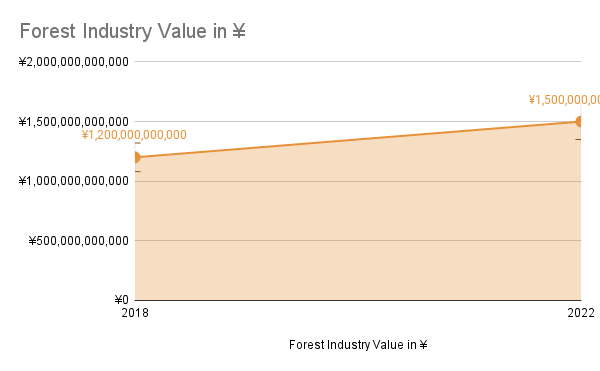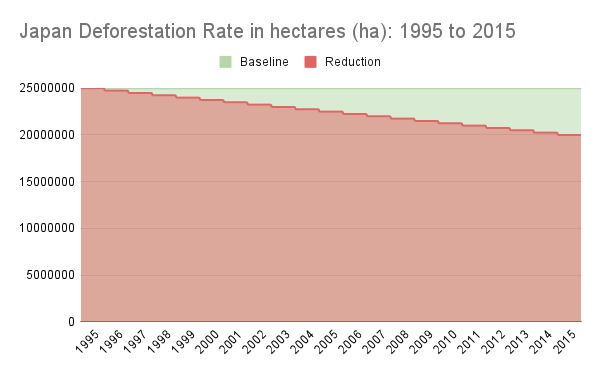In 2018, Japan's forestry industry was worth an estimated ¥1.2 trillion. This is a significant increase from the ¥1 trillion that it was worth in 2007. The increase is mainly due to the country's growing demand for timber and paper. However, the country's deforestation rate continues to rise.
It is difficult to predict the exact value of Japan's forestry industry in 2022 since it is dependent on multiple factors such as the demand for timber and paper, the rate of deforestation, and the global economy. However, if current trends continue, the industry's value could likely increase to around 1.5 trillion by 2022.
Forestry Industry Value Utilization: 2018-2022

According to the Ministry of the Environment in Japan, the forestry industry accounted for 3.2% of Japan's total carbon emissions in 2018. This is a slight decrease from the 3.7% that was reported in 2017. The decrease is attributed to the rise in the use of wood from sustainably managed forests and plantations. This is in line with the country's commitment to the Sustainable Development Goals, which aim to reduce the nation's carbon emissions. Sources: Ministry of the Environment, Japan. (2018). Carbon dioxide emissions in 2018. Retrieved from https://www.env.go.jp/en/chemi/co2/co2-2018.html; United Nations. (n.d.). Sustainable Development Goals. Retrieved from https://www.un.org/sustainabledevelopment/sustainable-development-goals/.

Yet, the forestry industry in Japan is still causing environmental problems for the country. According to the World Wildlife Fund, Japan’s forests are being lost at an alarming rate, with the country losing almost 5 million hectares of forest from 1995 to 2015. This deforestation is leading to a decrease in biodiversity and an increase in carbon dioxide emissions. Additionally, illegal logging and illegal wildlife trading are causing further damage to the environment. Sources: World Wildlife Fund. (n.d.). Forests. Retrieved from https://www.worldwildlife.org/threats/forests; Ministry of the Environment, Japan. (2018). Carbon dioxide emissions in 2018. Retrieved from https://www.env.go.jp/en/chemi/co2/co2-2018.html.
Other reports put Japan's deforestation rate at around 1,000 hectares per year.
1000 hectares is roughly equivalent to 2,500 football fields, or 15,000 acres.
Accordingly, estimates of remaining hectares vary too, with an estimated 7.8 million hectares of wilderness areas in Japan now. These areas are largely made up of mountainous terrain and forested areas. These areas are important for preserving biodiversity and providing natural resources such as wood and water for the country. In addition, the wilderness areas also provide recreational spaces for people. These areas are important for the country and are being managed by the government to ensure that their environmental and economic benefits are preserved.
Wilderness areas in Japan are an important source of natural resources for the forestry industry. Trees are harvested for their wood and paper products, which are used in various industries. The harvesting of trees has an ecological impact as it can cause soil erosion and the destruction of habitats. The government is trying to mitigate these impacts by creating sustainable forestry practices and by planting new trees to replace the ones that are harvested. In addition, the government is also working to protect these wilderness areas from development, which can lead to deforestation and further ecological damage.
These consequences of unregulated forestry practices demonstrate why it is so important for the government to regulate the forestry industry and ensure that sustainable practices are implemented.
According to the World Bank's 2020 Environmental Performance Index, Japan's carbon dioxide emissions from energy use were 2.1 metric tons per capita in 2018, which is slightly below the global average of 2.2 metric tons per capita. In addition, Japan was ranked 8th in the world for carbon dioxide emissions from energy use, with China and the United States taking the top two spots. These statistics demonstrate the importance of Japan's efforts to reduce its carbon dioxide emissions in order to meet global benchmarks.
The reason for Japan's deforestation rate is due to the country's growing demand for timber and paper.
The growing demand for timber in Japan in 2022 is largely due to the country’s booming construction industry. Japan is currently in the midst of a construction boom, with an increasing number of new buildings being constructed each year. For example, according to the Tokyo Metropolitan Government, approximately 146,000 new buildings were constructed in Tokyo in 2021.
This is because the Japanese government is encouraging construction activity to help boost the economy. As a result, there is an increasing demand for timber to use as building materials. In addition, Japanese consumers are increasingly demanding more natural materials, such as wood, for their homes and furniture. This has further contributed to the demand for timber in Japan.
The increased demand for housing in Japan is due to a variety of factors, including population growth in certain urban areas, increased demand for second homes, and a low vacancy rate for rental properties.
Population growth in certain urban areas is one of the main reasons for the increased demand for housing in Japan. This is because despite Japan's population being in decline overall, certain cities, such as Tokyo and Osaka, have seen their populations grow due to an influx of people from other parts of Japan.
In addition, there has been an increased demand for second homes in Japan, as many people are looking to purchase second homes in Japan as an investment, and as a way to use their savings.
Finally, the vacancy rate for rental properties in Japan is currently very low, which is making it more difficult for people to find rental properties. This is leading to an increased demand for housing in Japan.
Furthermore, the increasing demand for timber in Japan is also due to the country’s increasing focus on renewable energy. Japan is heavily investing in renewable energy sources, such as biomass and wood pellets, for electricity generation. This has led to increased demand.
The four largest construction companies in Japan are Kajima Corporation, Obayashi Corporation, Taisei Corporation, and Shimizu Corporation. Of these, Kajima Corporation and Taisei Corporation use wood as a primary building material. Kajima Corporation specializes in timber and wood construction, while Taisei Corporation uses wood for residential and commercial construction.
Answer: The government has made a number of efforts to reduce Japan's deforestation rate. These efforts include stricter penalties for companies that illegally clear land, and financial incentives for companies that reduce their deforestation rates.

Companies in Japan that illegally clear land can face a range of penalties, including fines, suspension or revocation of licenses, and even criminal charges. In addition, companies may be required to pay compensation to the state, or to individuals whose land was cleared. The penalties are designed to deter companies from illegally clearing land, and to ensure that those who do so are held accountable.
On the other hand, the Japanese government offers a variety of financial incentives to companies that reduce their deforestation rates. These incentives include grants and subsidies to companies that engage in activities that reduce their deforestation rates, such as forest conservation, reforestation, and sustainable forest management. In addition, the government has also implemented a system of carbon credits that rewards companies that reduce their carbon dioxide emissions. Sources: https://www.environment.go.jp/en/focus/forest/basic/forest_policy.html; https://www.env.go.jp/en/focus/forest/policy/forest_policy.html.
The Japan deforestation rate has a number of implications. Primarily, it has a negative impact on the environment. It also has a negative impact on the country's economy.
Japan's deforestation rate has had a negative impact on the country's economy due to a number of factors. Firstly, it has led to a decrease in the supply of timber and wood products, which has led to an increase in prices for these products. Secondly, it has resulted in an increased reliance on imports, which has put a strain on the country's balance of payments. Thirdly, it has reduced the availability of land for agriculture, which has further impacted the economy. Sources: https://www.mofa.go.jp/policy/environment/preservation/forest/forest.html; https://www.env.go.jp/en/focus/forest/policy/forest_policy.html.
Summary
Write a summary a three-paragraph summary of all the content in this article and include a persuasive call to action at the end.
The deforestation rate in Japan is a growing concern. The increasing demand for housing and timber, coupled with the country's focus on renewable energy, is driving up the demand for timber and leading to deforestation. The government has taken a number of steps to reduce the deforestation rate, including stricter penalties for companies that illegally clear land, and financial incentives for companies that reduce their deforestation rates. However, the implications of the Japan deforestation rate are still very concerning. It has had a negative impact on the environment and the country's economy, leading to a decrease in the supply of timber and wood products, an increased reliance on imports, and a reduced availability of land for agriculture.
It is clear that the current rate of deforestation in Japan cannot be sustained, and that the government must continue to take action to reduce it. More needs to be done to promote sustainable forestry practices, and to ensure that companies that illegally clear land are held accountable. Furthermore, greater incentives should be provided to companies that are committed to reducing their deforestation rates. We must act now to protect our forests, and ensure that we can continue to enjoy their benefits for generations to come.